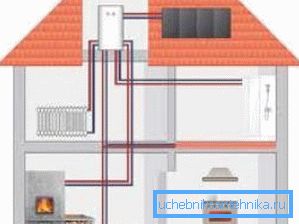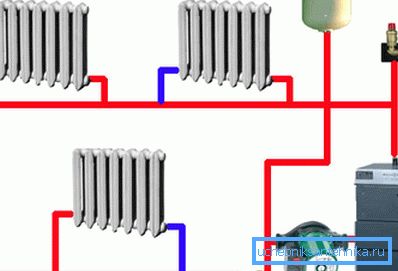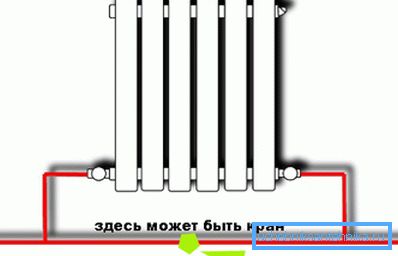Is the floor-based two-pipe heating system of a two-story
At present, both a two-pipe and a one-pipe heating system of a two-story house are used, and each of them, as often happens when comparing, has its own positive and negative sides that guide their choice. Anyway, any of these circuits is used to supply hot water to radiators.
Moreover, these systems are applicable even with a larger number of floors - the most important thing is to ensure proper pressure for circulation. And, nevertheless, let's consider the pros and cons of both circuits, and in order to help what was said, we will show you a video clip on the subject.

Radiator circuits
Advantages of radiator circuits

- Probably the main advantage of single-circuit or double-circuit radiator heating is its wide popularity for the entire population, the relative simplicity of installation and decent heating of the room, which is confirmed by many years of experience. The scheme itself is quite simple, therefore, you can see similar layouts in almost all residential and public high-rise buildings, industrial enterprises, schools, hospitals, and so on.
- But besides simplicity, there are also its charms, for example, you can install a thermostat on each individual radiator, as in the photo above, and this will allow you to create a separate microclimate in each room, although the overall temperature of the water supply will be the same. In addition, in our time, the installation of taps in front of each battery is practiced, which allows replacing it without draining water from the entire system.
- Now basically you can find two types of contours of steel and polypropylene pipes, although lately polypropylene has become more and more confident in leading positions, displacing metal. But the radiators themselves are still made of metal, and they are made of iron, steel, aluminum and bimetal (steel with aluminum).
Single circuit systems
Note. In any case, whether it is a single-pipe or two-pipe circuit, when distributing heating two pipes are used - supply and return. The difference lies in the wiring diagram of radiators.

So, let's understand what is the one-pipe heating scheme of a two-story house (or any other) and evaluate its advantages and disadvantages. As you can see in the upper image, the circuit is looped on the heating boiler (it can also be a stove with a water boiler and a circulating pump embedded in the system), and the radiators are embedded in it with both taps.
That is, from which pipe the coolant enters the battery, it returns to the same pipe only a few centimeters further (the connection itself can be lower, as in the diagram, upper and diagonal).
At the same time, it is not necessary for the radiators to be connected if the circuit is horizontal from the supply or return side, it can also be a riser - it all depends on the layout of the house and any instruction is inappropriate here.
This method of installation of heating is advantageous due to its low cost, since less material is used for the construction, which in turn reduces labor costs. Reducing the length of the line, which is always observed with such a wiring scheme, leads to a decrease in the coolant in the system, which allows you to spend less energy on heating.
Immediately we can say that the greatest effect is possible only if there are three or four radiators in one circuit, although some argue that the effect is possible even with five units, the main thing is that the proper pressure in the system is observed. The problem is that in each connection area the coolant is diluted with a colder liquid and after several points its cooling is already noticeable even when the radiator is feeling the hand.

Due to the loss of the temperature of the coolant, in some cases, residents cut the shut-off valves into the main between the radiator outlets so that the fluid circulates directly through the sections. This, of course, raises the temperature by a few degrees, but then the situation with the subsequent points becomes even worse.
Note. If you really want to install a single-loop system in a two-story building, then it is best for each group of 3-4 radiators to install a separate riser according to the collector principle.
Dual circuit systems

But most often when installing the heating system they use double-circuit systems, despite the fact that the price of their installation and material for the arrangement is much higher. The main advantage of such a system is that all the hot water moves along the same circuit, without being diluted along the way, but simply giving a part of the volume at each point, which, if there is enough pressure, does not affect the temperature of even the most separated radiators (see .Also article Two-pipe or one-pipe heating system - the eternal question).
At the very last radiator, the cycle ends, and the coolant through it enters the return pipe to which no device is already connected — the water returns directly to the heating boiler.
Of course, in such a combination more pipes are obtained, therefore, the volume of liquid that needs to be heated increases. But to save energy, you can make a contour of polypropylene and insulate it in the right places, so the heat loss will be minimal.
Conclusion
In conclusion, I would like to draw attention to two points that you will definitely have to face when installing heating in a two-story house with your own hands.
- First of all, Serve should always start from the top, in this case, from the second floor.
- Secondly, An additional circulating pump always crashes into the return pipe, most often at the boiler, although there are exceptions.
These two little things optimize the circulation of coolant.